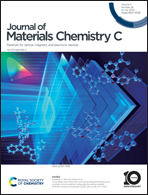Singlet exciton and singlet/triplet self-trapped excitons for ultra-broadband white-light emission in a zero-dimensional cadmium bromide hybrid†
Abstract
Zero-dimensional (0D) organic–inorganic metal halide hybrids have aroused heightened academic interest from the solid-state lighting field because of their abundant structural species and excellent photoluminescence properties. However, the synthesis of single-component white-light emitters with an ultra-broad emission band (>200 nm) remains a huge challenge. Here, we report on a 0D cadmium-based ultra-broadband solid white-light emitter using the luminescent active organic templates, namely (H2AMP)CdBr4·H2O (1, AMP = 2-piperidylmethylamine), containing isolated 0D CdBr4 tetrahedral anions separated by [H2AMP]2+ cations. Under 365 nm excitation, 1 shows an ultra-broadband “warm” white-light emission with a large bandwidth of 285 nm containing three emission bands at 451, 521, and 631 nm located in the blue, green, and red regions, respectively, which have a high color rendering index of 98 and a moderate photoluminescence quantum yield of 23.46%. Systematic investigations prove that the origin of white-light emission stems from the synergic work of singlet excitons bound in organic components as well as singlet and triplet excitons self-trapped into distorted tetrahedral substructures. To our knowledge, 1 should be the first observation of the coexistence of singlet and triplet self-trapped excitons in 0D tetrahedral CdX4-based metal halides at room temperature. Moreover, 1 is a direct bandgap semiconductor, as revealed by experimental results and theoretical calculations. Our work provides a novel approach for the development of single-component white-light emitters with more brilliant photophysical properties.



 Please wait while we load your content...
Please wait while we load your content...